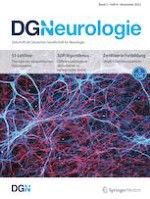Erschienen in:

29.09.2022 | Nimodipin | Arzneimitteltherapie
Therapie der Vasospasmen bei Subarachnoidalblutung
verfasst von:
M. C. Borutta, PD Dr. med. J. Koehn
Erschienen in:
DGNeurologie
|
Ausgabe 6/2022
Einloggen, um Zugang zu erhalten
Auszug
Die spontane nichttraumatische Subarachnoidalblutung (SAB) stellt mit einer Inzidenz von etwa 9 pro 100.000 und 5 % aller Schlaganfälle in westlichen Industrienationen eine seltene Form des Schlaganfalls mit einer vergleichsweise hohen Morbidität und Mortalität von bis zu 40 % dar. Betroffen sind v. a. Patienten jüngeren Alters um die 5. Lebensdekade [
1]. Nahezu 80 % der Fälle liegt ein zerebrales Aneurysma zugrunde. Begleitend treten oft intraventrikuläre und intrazerebrale Blutanteile mit der Gefahr eines konsekutiven okkludierenden Hydrozephalus und der Entwicklung eines Hirnödems hinzu. Eine Besonderheit stellt der zweiphasige Verlauf der Erkrankung dar: Nach einer initialen Schädigung binnen der ersten 72 h, welche auf die toxischen Effekte des subarachnoidalen Blutes, eine transiente globale Ischämie und eine direkte Schädigung des Hirnparenchyms durch eine mögliche intrazerebrale Blutung zurückgeführt werden kann, kommt es insbesondere an den Tagen 3–14 zu verzögert einsetzenden neurologischen Defiziten, den sog. „delayed cerebral ischemias“ (DCI). Pathophysiologisch liegen diesen u. a. zerebrale Vasospasmen zugrunde [
2]. Das primäre Ziel der Therapie einer SAB liegt im Ausschalten der Blutungsquelle mittels offen chirurgischer („clipping“) oder endovaskulärer Behandlungsoptionen (außer dem „coiling“ auch weitere Techniken wie der Einsatz eines WEB-Device). Neben der ggf. notwendigen Therapie eines Hydrozephalus oder Hirnödems rückt der Fokus im weiteren Verlauf auf die intensivmedizinischen Behandlungsstrategien zur Prophylaxe und Therapie der DCI, die maßgeblich das Patientenoutcome beeinflussen können [
3]. …